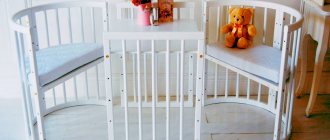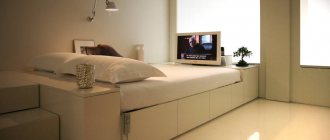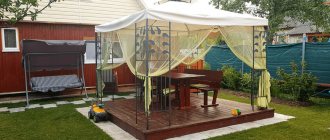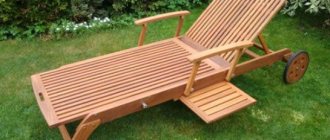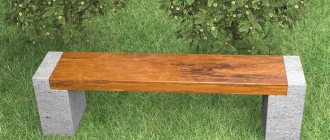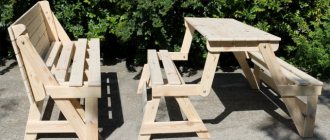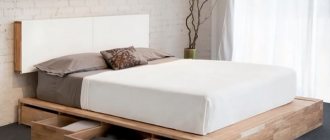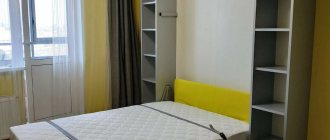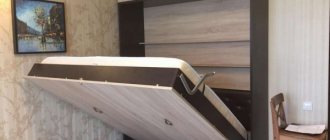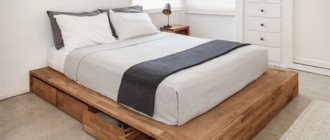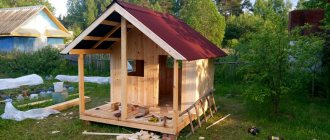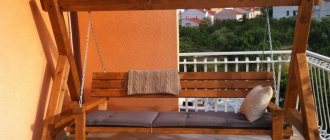A cradle is a small bed for a baby that is suspended in the air. This is one of the oldest and, unfortunately, most dangerous cribs for babies. If you do not follow the correct technology and use low-quality materials, the cradle may simply break off along with the baby. In this article we will tell you how to make a cradle for a newborn with your own hands, only it will stand on the floor for safety.
Let's go to the lesson
You can see the process of making a cradle in the example of a master class. We took the diagram from the last drawing and simplified it a little.
We cut out the headboard and legs, then cover them with colorless transparent acrylic varnish.
Next we make the sides.
You can buy these round sticks at the store, then you will need to sand them and glue them to two strips.
Making the bottom of the cradle. As you can see, we make it not from one thick board, but from slats.
We drill holes and begin to assemble the crib.
This is what should happen at this stage.
Cut out the legs in the shape of the letter "L".
Cut out the swing mechanism.
Let's collect it.
At night, you can clamp the discs with clamps so that they stick better.
We present a photo of the cradle that we got, from different angles.
We sew the sides and mattress cover.
Traditional wooden sway
To make it you will need:
- thin planks or plywood 1.5-2 cm;
- jigsaw or wood saw;
- screwdriver, self-tapping screws;
- drill and set of drills;
- thick fabric (denim or burlap, linen, etc.);
- strong rope, cable or trouser tape.
Scheme for making a hanging cradle.
- First, you will have to draw out on paper the details of the future crib: the sides and end parts. The sides should have a length equal to the desired length of the cradle, and a width sufficient to ensure that the child cannot accidentally fall out of it (approximately 35 cm). The end parts must be made in the form of a trapezoid, the smaller of the parallel sides of which will be at the bottom. The length of this side is equal to the desired width of the bottom of the cradle. The length of the upper side of the trapezoid is selected based on convenience. The bottom of the cradle was traditionally made of homespun cloth. Modern fabrics allow you to choose the most suitable material for individual needs. The main requirement for it: it must be dense enough to support the weight of the child. The bottom is cut out based on the size of the wooden parts along their lower edge.
- Mark and drill symmetrical holes in the sides of the cradle for hanging the box. It is best to place them closer to the upper corners of the parts. On the lower edge of the sides and end sides, mark and drill a series of holes with a constant pitch of about 3 cm. At the same stage, you can make carved decor along the edge of the cradle, if necessary.
- Assemble the box, connecting the sides to the ends using self-tapping screws. In the fabric bottom along the edges at a distance of 1.5-2 cm from the cut (on non-flowing fabric) or hem (on loose fabric with a processed edge), make holes along the perimeter with a pitch that coincides with the pitch of the holes on the wooden box. Overcast the edges of the loops. Connect the bottom to the box with a thin cable or rope, threading it through the holes on the wooden parts and fabric parts. Thread a rope or trouser tape through the hanging holes and secure the finished hanging cradle to the ceiling in the desired location.
Sweet nest
The process of creating a nest for a cradle with your own hands can be followed using the example of a master class. For this we will need cotton fabric measuring 80*100 cm, you can take two pieces of one or more colors, openwork lace and satin ribbon about three meters, holofiber or padding polyester.
First, we make a pattern. It is perfect for kids. It can also be downloaded from the link below.
Then we baste two pieces of fabric and lace. The front side should face inward. We begin to stitch and overcast the fabric. You need to make very neat seams for beautiful edges. Next, turn the nest inside out and steam the edges.
Related article: DIY rompers for newborns: diagrams with photos
Stepping back two cm from the edge, sew the seam. We'll need it a little later.
We cut out and round the edges a holofiber measuring 70*35 or use padding polyester. Now we fill the nest with it and make a couple of horizontal seams. Also, don’t forget to stitch the side of the cocoon.
Then we stretch the satin ribbon. To make this job easier, use a pin.
We stuff the sides and hand stitch the open edges.
We tie a bow with a satin ribbon. The wider you take the ribbon, the larger the bow you will get.
Also, do not forget that when there are large edges left, there is no need to trim them. Thanks to them, you can adjust the length of the nest.
We sewed this cute nest for a newborn ourselves. As you can see, there was nothing complicated in the sewing process. The result is simply impressive! And the edges of the nest can be crocheted.
How to make a wicker cradle with your own hands
Every mother can try to make a beautiful and creative wicker cradle on her own, putting a piece of her love into it. It's quite simple if you use the advice of experienced needlewomen.
Wicker product with a piece of mother's soul
Such a homemade cradle, among other things, will help you significantly reduce the cost of arranging a children's room.
If you plan to move the cradle to different rooms, you need to make several ceiling holders in advance.
Various techniques can be used to create this type of structure. If you are fond of the macrame technique, you can easily weave a beautiful and original hanging cradle for a newborn.
Maybe
Pattern-drawing of a cocoon
The figure below in the article clearly shows all the necessary dimensions for sewing a fabric cocoon for a child. Using this pattern, two identical parts are cut out of fabric. On the wrong side they are sewn along the edges, leaving only the flat lower part unsewn. The soft bottom of the cocoon will subsequently be inserted through this hole. This pocket will be closed with a snake, which needs to be sewn onto its edges.
Next, you need to roll up a “sausage” from padding polyester and insert it along the entire perimeter of the cradle, pressing it tightly against the side seam. Then only on the front side a seam is made along the line marked in blue chalk. All that remains is to cut the foam bottom to the required size, cover it with a layer of thin batting both above and below, and then insert it into the pocket reserved for this purpose in the center of the cocoon and fasten it with a zipper. A wide satin ribbon is sewn onto the edges of the thickened sides to tie a beautiful bow. This closes the cocoon from below.
The article presents several interesting examples of making cradles for newborn babies. Choose the manufacturing method you like and do the work yourself. Good luck!
Source
Description of the design and required materials
Option for a baby cot.
The proposed structure will not swing entirely. Only the cradle itself will rock. This type is safer and more reliable, since the cradle is protected from overturning. A do-it-yourself baby cradle made according to this principle will serve faithfully for all family members for many years. The design includes clamps that will prevent excessive rocking of the cradle.
The materials in this case will be:
- wooden shield;
- boards;
- self-tapping screws;
- glue;
- screwdriver;
- roulette;
- pencil;
- You can’t do this without a screwdriver and a hacksaw.
A milling machine will be used to cut out the shaped parts of the cradle. They are also provided in this case. The cutting begins with the end circle. In this case, the part must be tightly secured. This is done in order to completely prevent damage to the desktop on which all work is carried out.
The cradle frame must be assembled using self-tapping screws.
The bottom boards must be attached between the two backs using glue and dowels.
Now we can talk in more detail about how to make a baby cradle with your own hands.
How to choose a high-quality carrying bag in a store, what criteria to consider
The safety and health of the child depends on the quality of the carrying. Experts advise that when choosing such a necessary device for a baby, you should always pay attention to:
- manufacturing material. It must be hypoallergenic and completely safe for the baby. Natural cotton is preferred inside the cradle to minimize the likelihood of irritation and allergic reactions;
- bottom. It should be solid and not bend under the weight of the baby, ideally made of plywood. There are models with a plastic bottom, but experts do not recommend buying them: plastic cannot support the weight of a baby. If you buy a special coconut-based mattress and put it in the cradle, your baby will sleep comfortably;
- pens. They must be comfortable and durable, securely attached to the cradle and be of the required length;
- additional details. A hood, a cradle cover, a rain cover and a mosquito net are very important accessories that protect the baby from wind, bad weather and insects, so their presence in the kit is very desirable.
Cradle made of slats
For those who like to make wooden structures, there is another option for an original baby crib. It consists of two semicircular planks, for which several boards were first glued together, and then they were cut out from the resulting shields according to a pattern. The next step will be to connect them to each other with a number of identical slats, screwed on with screws on both sides. The bottom of the crib is made flat.
For beauty, stars were cut out on the sides with a jigsaw. All slats must be thoroughly cleaned so that the crib is smooth and safe for the baby.
Types of cradles
The offered range of cradles is not limited to the standard model. Modern shabbies are improved examples of their distant ancestors.
Classical
The classic version is the most common. The box is suspended on cables from the ceiling or mounted on the wall. Sometimes parents worry about the safety of the child and therefore refuse this model, which is quite natural, although in vain - the designs are initially designed to withstand loads that greatly exceed the weight of even a very well-fed baby.
A positive feature of such a cradle is the ease of motion sickness. You don’t need to constantly stand nearby: one touch with your hand and the cradle will continue to swing by inertia for a long time.
Bassinet swing
Essentially, these are small swings mounted on stands. The cradle has built-in seat belts, which is very important, since the sides of the box are small. In many models, the backrest is adjustable to the position of the body, which allows the child not only to lie down, but also to sit. They are recommended for use for children whose weight does not exceed 18 kg.
A swing cradle is an excellent way to calm a child, which has a positive effect on coordination of movements and the vestibular system.
Automatic
An automatic cradle is an electronic swing cradle. It comes with a remote control, a night light, and a soothing selection of music. This model will save parents a lot of free time, but it is still not recommended to sleep in it for a long time - it is better to use it exclusively to calm and lull the baby.
This model is best used as an additional sleeping place to the crib.
Hanging cradle for crib
This is an indispensable item for those who already have a stationary crib. As a rule, it is almost impossible to pump it - only roll it if it has wheels. And if they are not there, a fabric cradle will help out - it is easily attached to the sides of the crib and just as easily removed when there is no longer a need for it.
Where is the best place to install
The best place for a newborn baby is next to his mother. Therefore, installing a cradle next to the mother’s sleeping place, especially at first, is the most reasonable solution.
A little later, after 6-7 months, you can begin to teach the child to sleep in his own room. But in this case, the cradle will no longer be useful - the child will need a full-fledged crib.
Useful accessories
A canopy suspended above the cradle creates a cozy “house” and gives a feeling of security and peace. Thanks to it, a bright sunny day or light in the room will not prevent the child from sleeping peacefully.
Toys hanging on an arc built into the cradle will not leave any baby indifferent. In some models, they can move in a circle to soothing music, which helps the child fall asleep quickly. For those who are afraid of the dark, there are small star night lights.
Many modern electronic cradles have remote control using a remote control.
Features of the hanging cradle
Newborn babies have an increased need for sleep—some sleep up to 13 hours a day. Therefore, arranging a comfortable and safe place for the child for this purpose is the primary task of parents, which a hanging cradle can help with.
A cradle is often a rocking box bed suspended from the ceiling. It is small in size, so it is intended for rocking babies only up to six months, while the baby is not yet able to sit.
Benefits of use
The choice in favor of a cradle is largely justified from the point of view of the child’s comfort - the conditions of some weightlessness that the cradle creates are more familiar to a newborn, it creates a feeling of the same security and safety as the mother’s belly. According to experts, the cradle allows you to smooth out the sharpness of the child’s transition from one world to another, preventing additional stress from arising.
Pros of use:
- a convenient and easy way to rock a baby;
- no load on the back (as opposed to being cradled in the arms);
- small design dimensions;
- mobility;
- ease.
It has been tested in practice that children in a cradle fall asleep much better and have healthier sleep. The small space of the box creates the illusion of being in the mother's womb; the baby feels safe, so he sleeps more peacefully. In addition, the mother no longer has to constantly rock the baby in her arms, which gives her more free time and the opportunity to do other things.
The cradle can be installed in any convenient place in the house: due to its small size, it will not take up much space, and the “airiness” of the design will not give the impression of a cluttered space. For small apartments it may be the best option. If necessary, it will not be difficult to move the cradle to another room - the light weight of the box allows this to be done.
Flaws
If during the manufacture of the cradle all safety standards were observed and reliable materials were used for the construction, then there are no shortcomings as such. The only disadvantage of any cradle model is the short period of use.
Most cribs are designed for newborns, so after the baby begins to sit up (about six months), the sleeping place will have to be changed and purchased a more spacious stationary crib.
